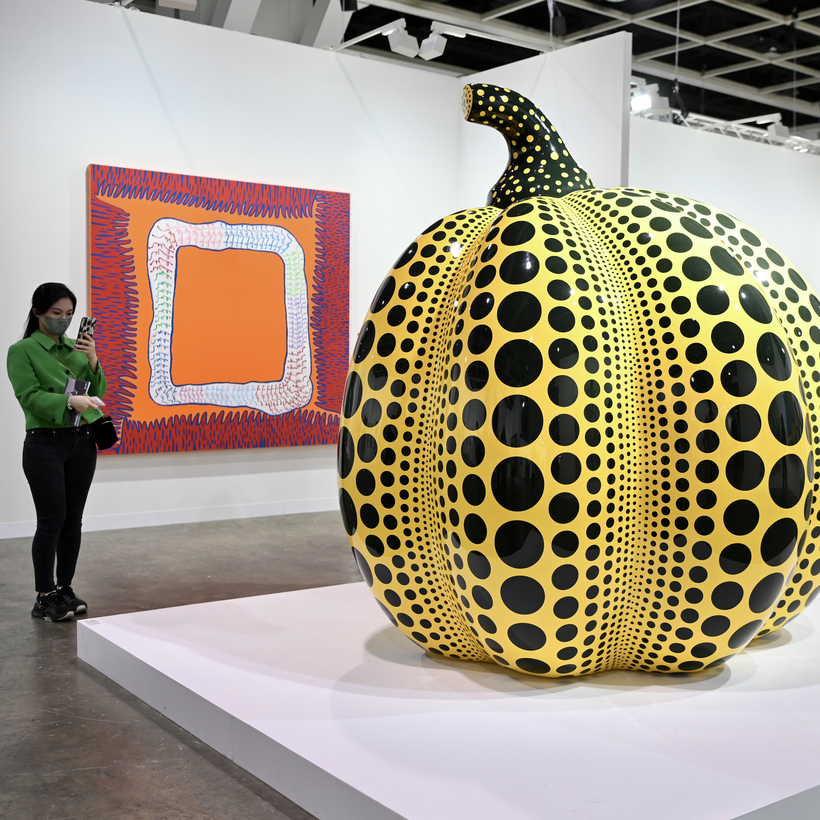On March 20, at the start of Art Basel Hong Kong, Phillips auction house unveiled its dazzling new Asian headquarters with a neon-lit party for about 800 collectors.
“No other auction house in Hong Kong has this,” declared Jonathan Crockett, Phillips’s chairman for Asia, dressed in a taupe Zegna ensemble and sneakers. He stood next to a gold Takashi Murakami flower sculpture that sold 10 days later for $1.78 million.

The 52,000-square-foot project at the base of an austere cement tower occupies six floors and includes a transformable glass-walled gallery and sales floor. It sits just opposite the ambitiously perpendicular M+ museum, which opened in 2021; both buildings are by Herzog & de Meuron.
The move will allow Phillips to host sales throughout the year, rather than seasonally, as was the custom. It’s also an attempt to amplify its branding by staking a claim to the city’s sprawling new cultural district, in West Kowloon. Crockett was right, technically—it’s a one-of-a-kind masterpiece. At least for now.

Despite its political turmoil, Hong Kong retains the ability to attract collectors throughout Asia whose interest in acquiring the masters of Western art is only increasing. Hong Kong has no customs tariff, sales tax, or value-added tax, making it more appealing to buyers than cities such as Singapore and Seoul.
Last year, Asian buyers accounted for 26 percent of global sales at Christie’s, about 34 percent at Phillips, and nearly 40 percent at Sotheby’s. Their representation is even higher among younger buyers, who tend to collect across categories. The auction houses are taking great pains to court this influential group by marketing themselves like the luxury-fashion houses, which this same group of buyers patronizes so loyally.
In the dense Central District of Hong Kong Island, Christie’s is also hard at work expanding and relocating its Asia-Pacific headquarters. Its 50,000-square-foot space is in a new building designed by Zaha Hadid Architects that will open next year, and it, too, will have a year-round sales floor.

And in a similar move that has particularly excited the city’s beleaguered retail industry, whipsawed since 2019 by violent street protests and the pandemic, Sotheby’s is taking over a two-story, 24,000-square-foot building currently occupied by a Giorgio Armani boutique. With street-level exposures and pedestrian walkways that connect to bustling shopping malls and commuter hubs, it may feel more like an emporium than an auction house.
With all of this commotion, the three houses are exploring new ventures and partnerships that target younger, aspirational customers. They will host gallery shows and “buy now” sales to unload watches, accessories, and limited-edition prints. Both Sotheby’s and Phillips plan to operate their new galleries 365 days per year, and they will include cafés in hopes of luring potential clients in from the street.

The competition to assert primacy in the Hong Kong art market, considered to be the second- or third-largest in the world, has been on full display during a week of nonstop parties and previews for collectors, including at a revitalized Art Basel event that many had previously left for dead.
Unexpectedly, Phillips, Sotheby’s, and Christie’s have also hosted events at shopping malls and street-art pop-ups. Their rivalry is such that Francis Belin, the president of Christie’s Asia Pacific, made sure to note that Christie’s, of the three, was “the first one to announce expansion of APAC headquarters among international auction houses back in July 2021, leading the art ecosystem in Asia Pacific.”
During Art Basel, the trio of competitors pulled out their brightest, shiniest objects. Christie’s presented several pieces from two of its major May sales: David Hockney’s Felled Trees will be included in the third installment of Visionary: The Paul G. Allen Collection, and works by Picasso, Roy Lichtenstein, and Francis Bacon that belonged to the late S. I. Newhouse, Jr., were each valued at more than $20 million. Sotheby’s, marking its 50th anniversary in Asia, installed two large Yayoi Kusama sculptures, a bronze pumpkin sculpture, and an infinity mirrored box in the Landmark Atrium shopping mall. Phillips showed off a pristine “Pumpkin” painting that sold on Thursday for about $7.15 million and a 1937 Patek Philippe watch that was owned by the last emperor of China.

“The business is changing, not just here but globally,” said Alex Branczik, a Sotheby’s senior director who is chairman of its Modern & Contemporary Art division in Asia. “What we do in Hong Kong will be the blueprint for other spaces at Sotheby’s around the world.” Expect these transformations—and turf wars—to continue apace.
Eric Wilson is a veteran fashion reporter currently based in Hong Kong. He was previously editorial director for Tatler Asia Group, fashion-news director for InStyle, and a reporter for The New York Times and WWD


